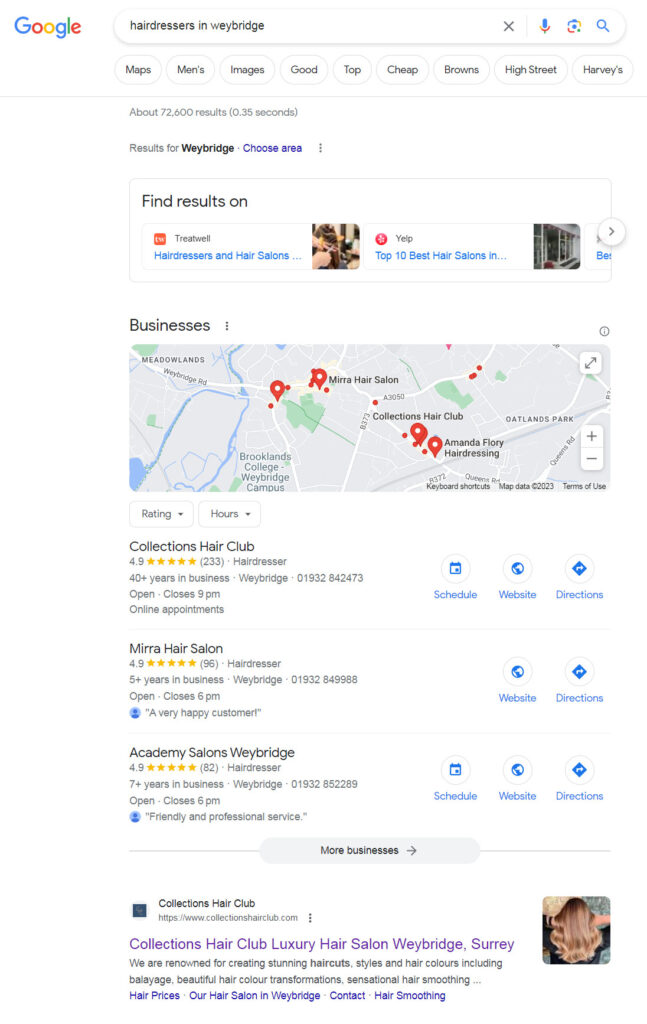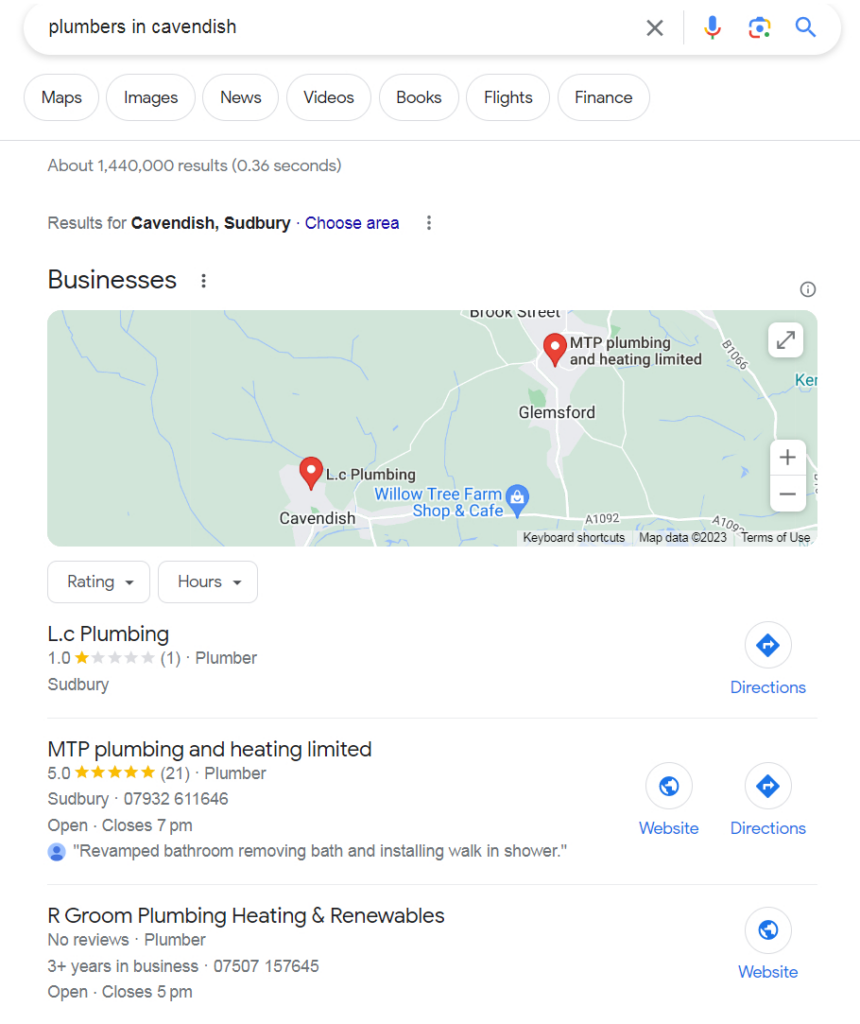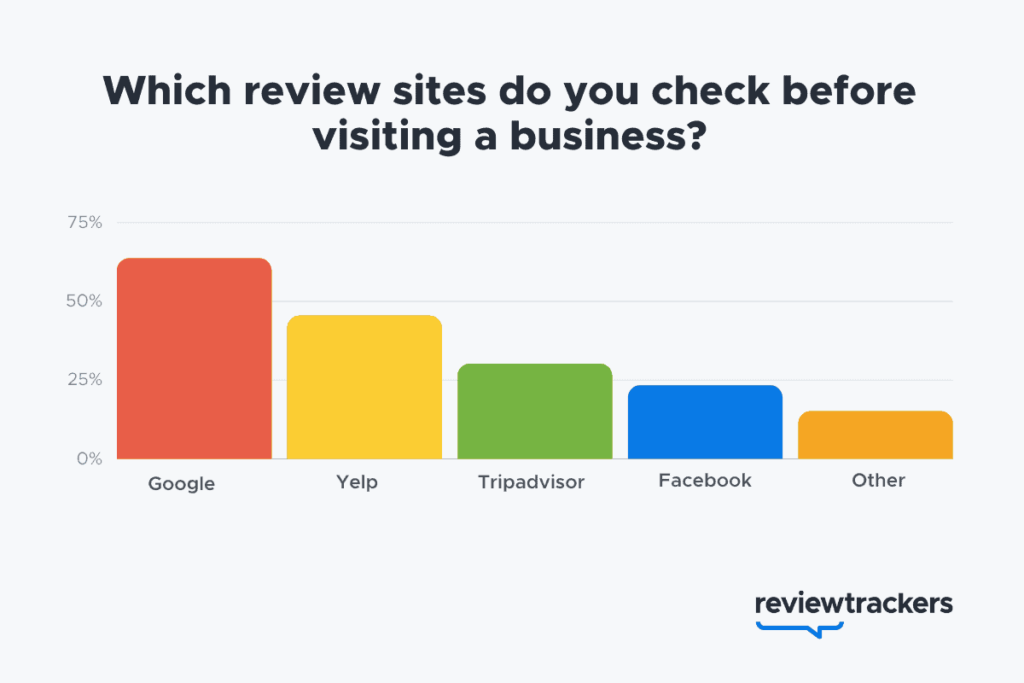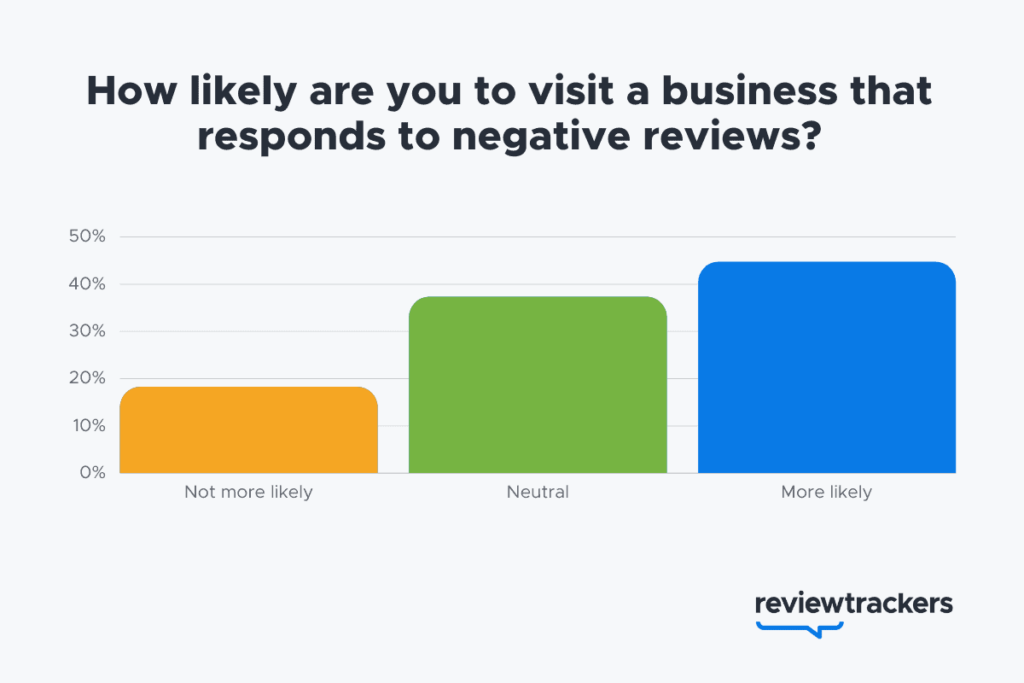Google Reviews for SEO & Local Businesses: 2023 Edition
Jump to a section: Map Packs, Understanding star ratings, More reviews, Responding to reviews, Things to avoid
 Digital marketing has become more complicated over the years. As well as needing to have a good quality website as a baseline, there are also a host of other factors that determine how well that website will perform in search results, that are nothing to do with the website itself.
Digital marketing has become more complicated over the years. As well as needing to have a good quality website as a baseline, there are also a host of other factors that determine how well that website will perform in search results, that are nothing to do with the website itself.
One of these factors is the number and quality of your reviews on Google, the seller (star) rating that Google gives to your business, and just reviews in general.
Local vs global rankings
There are two kinds of SEO – local and global. If you operate a business out of a physical location and serve customers there, such as a hair or beauty salon, that is considered a local business and that’s where the term ‘local SEO’ comes from. On the other hand if you have a website which is location independent such as a big brand like L’Oréal, you are operating on a global level.
The way that search works depends on whether or not the search term refers to a specific locale. If you search for something and add on the name of a place such as a city, or you use words such as ‘near me’, Google understands that this is a local search and adjusts its results accordingly. There are almost 100 billion local searches made in Google every month!
Why is this important? Because Google understands that if you go online to find a hair salon for example, you are likely to want one that is relatively close to you. You don’t care who is the best hairdresser in the whole country as you’re not going to drive hundreds of miles for a hair cut. As such, Google tailors it’s results to businesses within the local vicinity of either where you specify in your search query, or where you are physically searching from.
One of the most important things to understand is that Google will include a ‘map pack’ in any local search, which drastically alters the results that come up for the searcher. See the screenshot below:
Here I have searched for “hairdressers in weybridge”. You’ll see that just underneath the number of search results it says “Results for Weybridge” and a link next to it saying ‘Choose area’. Google has taken the locality of Weybridge from the search term and has looked for businesses in that area matching my search query.
There is a box showing other places to find results from and then underneath that you have what is known as the ‘map pack’. This is a small interactive map of the area with various businesses pinned within it, and underneath that you’ll see 3 businesses highlighted prominently along with a star rating (it’s actually called the Seller Rating by Google), the number of reviews and some other business details.
Then underneath all of that we finally get to what is known as the organic results. You’ll see from this image that Collections Hair Club (one of our clients) appears as the first entry in the organic results but it is also the first entry in that all important map pack.
Those map pack listings are incredibly important because they drive such a huge percentage of the clicks as they rank higher up than the organic listings (around 45% of the clicks). Nowadays Google is heading more and more towards these kinds of search results, with a whopping 93% of local searches having the map pack take up the number #1 spot!
If your business is not appearing in that pack of 3 businesses shown under the map, your chances of getting a click are slashed in half even if you rank highly in the organic results.
Now clicks to your website are what you want of course as this is how you get new customers into your business. However this is not the only benefit; the click through rate (CTR) of your website is also a ranking factor in itself. It’s one of those things that compounds as the higher the ranking, the better the CTR, and the better the CTR, the higher the ranking!
It’s not just about SEO
Whenever we talk about any aspect of online marketing, what we have to remember is that ultimately, all marketing has one singular purpose: to put more money in your pocket. Your business revenue is the only real KPI that matters; everything else is just helping to work towards that goal. I say that because I want to illustrate a case where the ranking is almost irrelevant:
This is one where I think Google got it a bit wrong:

In this search, the company ‘L.c Plumbing’ may have somehow snagged the top spot in the map pack (it won’t last long I’m sure), but how many clicks do you think that listing is going to get?
That single review and just 1 star really stick out like a sore thumb in an incredibly negative way. The 3rd listing for ‘R Groom’ simply doesn’t have any reviews so no stars are shown at all.
This leaves the middle listing for ‘MTP Plumbing’ really standing out here. They have 21 reviews, 5 stars (which is pretty rare!), and a recent comment from one of the reviews has been highlighted.
Even if your local SEO is solid and you rank highly, if your reviews don’t back up that ranking, and your competition have more and better reviews than you, then the fact that you outrank them won’t make any difference – they will be the ones to get the click!
Take away so far: reviews matter. A lot.
Now that we have established just how important it is to get good reviews and have a high star rating, let’s dig into the mechanics a little bit, discuss some strategies for encouraging your clients to leave you a review, and talk about things you need to avoid at all costs.
Understanding the star rating
Now one thing that is important to add in here is that the Google star rating is NOT actually made up of just the Google reviews! There is a complex algorithm behind the rating; it isn’t simply an average of the number of stars that the individual reviews are given as some people believe.
Multiple review sites
In actual fact Google aggregates data from multiple third party review sites, including social media reviews and adds that into the reviews from its own platform. If you take a look at Google’s page about seller ratings, you’ll find a massive list of sites that they use to pull their data from.
Now this list can look a bit overwhelming at first and you might start thinking that you have to start using all of these sites. As with most things in life, you can gain the mast majority of the benefit from focusing on just a few things.
Review Trackers is a website that gathers all manner of statistics about reviews and their 2022 report reveals a lot of very useful information. For example, when looking at what websites are used to post reviews, 88% of all reviews are placed on just 4 sites, with Google’s own platform (Google My Business) taking the lion’s share of over 63%.

Now what is also really interesting here is that if you look back at the list of sites from which Google aggregates, Yelp, Tripadvisor and Facebook are not on there! But as we explained earlier, getting a good review isn’t just about SEO, it’s about increasing the bottom line to your business.
The takeaway here is that if your company has an online presence on any of those 3 platforms, you want to be encouraging reviews there, as well as on GMB, but if you don’t, then just concentrate on Google reviews.
Sentiment of reviews
Google is an expert at ‘reading’ text and ascertaining what it is about and so on. Obviously the star rating of a review indicates whether or not the review is favourable, but Google will also read the text of the review content and factor that into it’s seller rating.
Note that there are some (many?) people who will leave a star rating, but not actually write any text. People are lazy. To leave any kind of review at all takes effort, which is why it can be difficult to get them. To actually write a thoughtful comment about the experience had with the company takes even more effort.
Furthermore, when writing a review about a business, the reviewer will use words that relate to the business. Now one thing to understand here is that using keywords within the review text are not a ranking factor. So don’t start asking your customers to write weird keyword-stuffed reviews! That is 2008 style SEO and does not wash these days. However, the words used within the review text do still help Google understand what the business is about which is very important for SEO in general.
So what is better, a 5-star review with no explanatory text, or a 4-star review with a well thought out comment? Only Google really knows the answer to that but the takeaway point is that you want to encourage your customers to write something about their experience.
Frequency, recency & spam
One of the things that Google loves is fresh content, which is one of the reasons why every business should have an active blog. When it comes to reviews, it is much better to have a steady stream of reviews coming in on a regular basis than to get a flood of reviews all of a sudden and then none for a long time.
The latter pattern simply doesn’t look natural at all and Google will weed out and actually remove reviews that it thinks have been created unnaturally and look like spam. They do this via their algorithmic review filter which runs periodically. You might have some reviews that stick around for a long time and then mysteriously disappear – this will be the review filter at work.
Reviews have a date on them and more recent reviews will carry a much higher trust factor than older reviews. This is not just the case for Google’s algorithm but also for humans reading through your reviews. Humans are going to give much more weight to reviews left a week ago than those left a couple of years ago; that’s just common sense.
How to get more reviews
We have examined why reviews are so important, how their help not only your SEO efforts but your business overall, and we’ve had a look at some of the mechanics of how the ratings are constructed. Let’s now explore the ways in which you can try to attract more reviews for your business.
Ask your clients directly
Whilst a review can be left at any time, people tend to forget over time. Even if they are super happy with your service and have posted a nice selfie on social media (they did tag your business right??), it might not occur to them to leave an actual review.
The solution here is to not only ASK the customer to leave a review, but to do so while they are still on your premises. This is the point at which the customer is happy with their service and it is freshest in their mind.
For salon owners who are reading this, the ideal opportunity to ask for a review is whilst they are still in the chair. You can ask them if they would like you to take a photo for them and use this opportunity to say something along the lines of, ‘hey, if you like what we’ve done today it would be awesome if you could leave us a review on Google, and post this photo too as it really helps!’ – or whatever works for you and your salon vibe.
Ask your clients via email
The next logical opportunity would be in a follow up email. You should capture the email address of anyone who uses your services and it’s always a good idea to send a follow up email remind them to book their next appointment if they haven’t done so already, and to leave a review.
Now you might find that there are cases where the customer actually wasn’t perfectly satisfied with your service but didn’t say anything at the time. This is very common in the UK in particular! If this is the case, you do still want the review because firstly it gives you valuable feedback on how your service can be improved, and secondly, it gives you an opportunity to respond which we’ll talk about in the next section.
Ask on social media
This is a technique that is only worth doing if you already have a good engagement level on your chosen social media platform. If you do then you can occasionally put out a post with a nice photo of the work you’ve done with a happy client, showcase the positive review that they left and then ask any other happy clients who may be reading to also leave a review for you.
Make it easy to leave a review
This point is especially important if you have more than one platform on which you wish to gather reviews for your business. It’s a good idea to have a page on your website about reviews. You might want to showcase some of your best ones but make sure to include a prominent link to the exact review URL. Don’t make the customer have to do the legwork of hunting it down. Even having to do a simple Google search becomes a barrier.
Better still, grab the URL and then use a shortener such as Bitly to make it short and easy to remember. For example:
https://bit.ly/ReviewSalonGuru
If you want to get really fancy, you could install a simple kiosk (could be as simple as a tablet on a stand) in your premises which is pre-loaded with a page showing some buttons they can click to go leave a review.
Amaze your customers!
This one might seem obvious but I feel it is worth stating anyway; the best way to get great reviews for your business is to do fantastic work for your clients! Make them happy and they will be glad to leave a glowing review, often without even being asked.
Responding to reviews
Hopefully your customers experience with your business will always be a positive one and you’ll never have to deal with a negative review, but if it does happen, it’s important to respond to the review, to do so professionally and as quickly as possible.
Sometimes your client will have a genuine reason to write something negative. If they do that you have got some very valuable feedback about something you can do to improve your business. Try not to get upset by the review – this feedback is gold! Most people who experience a bad service don’t say anything to the company but never go back and furthermore tell a whole bunch of their friends about it. So remember that every negative review is actually a very valuable opportunity for improvement.
Always, always, always thank the customer for leaving the review. If necessary, apologise for what went wrong. Have a think about what you can do to prevent the situation from happening again in the future and explain those action steps in your response.

There will be times of course when something goes wrong that is completely out of your control, such as being out of stock of something due to a shortage from a supplier. In this kind of situation, take responsibility (even when it is not your fault) and apologise anyway. You must always be polite, and never condescending in any way.
There will also people who just complain for the sake of it; those people who complain about everything; they are never happy. Their never like a haircut they received, they never like a meal they have ordered and so on. These people can be incredibly frustrating to deal with but you have to remember that their negative review stays on your profile for all to see whether it was justified or not! So once again the advice is to respond quickly, to stay polite, to apologise and state what action steps you will take to attempt to resolve the situation in the future.
Responding quickly to a genuine complaint may just turn an unhappy customer into a happy one. It will also impact anyone else who may be reading those reviews, and that includes Google. Responding quickly to reviews, particularly negative ones are another ranking factor.
What about positive reviews? It would be nice to be able to respond to all reviews but that might not be practical, and you want to avoid ending up just cluttering them with a lot of cookie cutter “Thank you very much” responses. I’m sure you’ve seen cases where a company has a standard response that they paste in every response and that can be even more irritating than no response at all.
If you are going to take the time to respond, then do so individually. If you can’t think of anything to say other than a thank you, then not responding might actually be better.
When you do respond, you want to show that you have actually read the message and that you are paying attention. Address the person by name and respond to the individual points made in the review. So for example, let’s say they complain about a particular member of staff and mention their name. You can respond by saying that you will speak to that person (mentioning the name) which shows that you have actually read the review properly.
Things to avoid
Lastly, let’s take a look at things you want to avoid doing.
Don’t buy reviews
By now you should be convinced of the positive impact of getting reviews to your business, but it’s also not that easy to do because you have to rely on other people – it’s not something you can directly control. You may be tempted to buy some reviews online. There are certainly enough places selling them and even some seemingly reputable people vouching for them.
Just don’t do it!
It should be obvious that this kind of manipulation is a bad idea. Remember Google’s review filter algorithm? You might think you’ve gotten away with it for a while but its only a matter of time before they will be detected and removed and your all important seller rating penalised as a result.
Even if you somehow manage to get past the automatic filter, these kinds of fake reviews will be easily detectable by any human with half a brain and so it will only damage your all important reputation. Even if websites state that they can supply ‘genuine’ 5-star reviews and they have a slick website and look reasonably priced, just say no. The only truly genuine review is one left by one of your clients.
Don’t incentivise your customers
Okay so I’ve convinced you of the importance of only getting genuine reviews so you may start thinking about ways in which you can encourage your clients to leave one. You might be tempted to offer a discount, a small freebie or perhaps use the leaving of a review as a criteria for entering a contest you are running.
Again, just don’t do it! It goes against the T&Cs of both the review platform, and if you are running a Facebook competition for example, you will also be violating Facebook’s terms by requiring a review for entry. You’re just going to get yourself into a mess of trouble doing this!
Never be rude, sarcastic or patronising
When dealing with negative reviews in particular, especially those that you feel may be unjustified, you may be tempted to try and put the reviewer ‘in their place’ so to speak. Yes the negative review may indeed be unjustified and some people may find it justified or even amusing if you respond in this way, your overall reputation suffers.
Once you stop being professional you delve into being petty and that is just not the way to run a business. In contrast, always maintaining the utmost politeness and professionalism will stand you in good stead for anyone who might read that review in the future.
If you are feeling angry about a review, then wait a little while before responding. Yes it’s important to respond quickly but it’s even more important to respond in the correct way.
